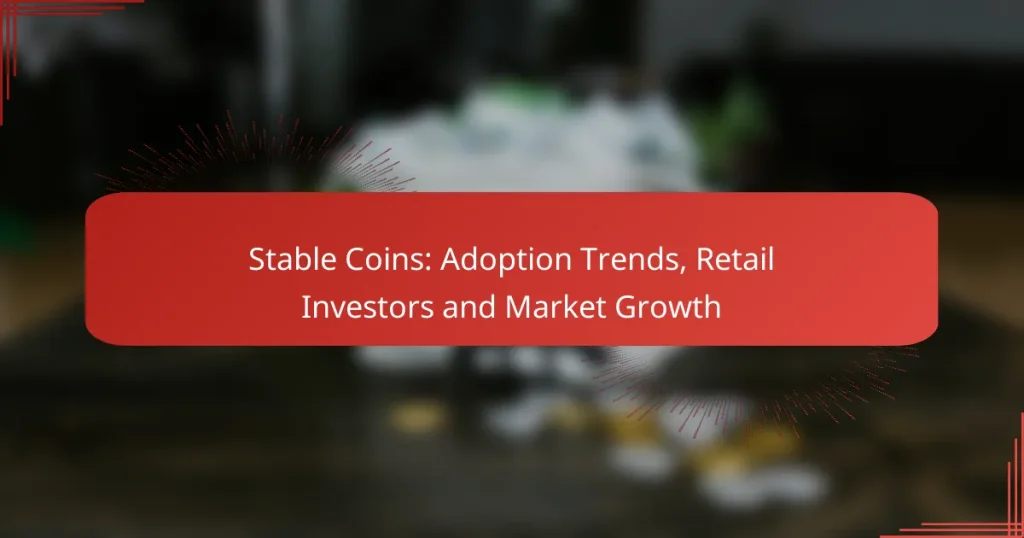Stable coins are gaining significant traction in the US, largely due to their perceived stability and versatility across various financial applications. Retail investors play a crucial role in this trend, as their demand for low-volatility assets and participation in decentralized finance (DeFi) activities shape market dynamics. The growth of stable coins is further fueled by increasing regulatory clarity, strategic partnerships, and advancements in blockchain technology, enhancing their appeal to a wider range of investors.

What are the current adoption trends of stable coins in the US?
Stable coins are increasingly being adopted in the US, driven by their perceived stability and utility in various financial applications. Retail investors, decentralized finance (DeFi) platforms, and payment systems are key areas where stable coins are gaining traction.
Increased usage among retail investors
Retail investors are turning to stable coins as a way to mitigate volatility while participating in cryptocurrency markets. Many use stable coins to hold value during market fluctuations, allowing for easier trading and investment strategies.
Platforms like Coinbase and Binance facilitate the buying and selling of stable coins, making them accessible to a broad audience. This ease of access encourages more retail investors to incorporate stable coins into their portfolios.
Growth in DeFi applications
The DeFi sector is experiencing significant growth, with stable coins playing a crucial role in enabling various financial services. They are commonly used for lending, borrowing, and yield farming, providing users with opportunities to earn returns on their holdings.
Stable coins facilitate seamless transactions within DeFi protocols, allowing users to avoid the volatility associated with traditional cryptocurrencies. This functionality is attracting both new and experienced investors to explore decentralized finance options.
Integration with payment platforms
Payment platforms are increasingly integrating stable coins to enhance transaction efficiency and reduce costs. Companies like PayPal and Square are exploring ways to allow users to transact with stable coins, making digital payments more stable and predictable.
By using stable coins for transactions, businesses can avoid the price fluctuations typical of other cryptocurrencies, leading to more reliable pricing for goods and services. This integration is likely to drive further adoption among consumers and merchants alike.

How are retail investors influencing the stable coin market?
Retail investors are significantly shaping the stable coin market by driving demand for low-volatility assets and participating in various decentralized finance (DeFi) activities. Their growing interest in stable coins is influencing liquidity, investment strategies, and overall market dynamics.
Preference for low-volatility assets
Retail investors often seek stable coins for their ability to minimize price fluctuations compared to traditional cryptocurrencies. This preference is particularly evident during periods of market volatility, where stable coins provide a safe haven for investors looking to preserve capital.
For instance, during market downturns, many retail investors convert their holdings into stable coins like USDT or USDC to avoid losses. This trend highlights the importance of stable coins as a tool for risk management in retail investment portfolios.
Participation in yield farming
Yield farming has become a popular strategy among retail investors, allowing them to earn returns on their stable coin holdings. By providing liquidity to decentralized exchanges or lending platforms, investors can receive interest or rewards, often significantly higher than traditional savings accounts.
For example, platforms like Aave or Compound enable users to lend their stable coins and earn interest rates that can range from low single digits to over 10% annually, depending on market conditions. This incentivizes retail investors to hold and utilize stable coins actively.
Impact on liquidity pools
The influx of retail investors into stable coins has a profound impact on liquidity pools within decentralized finance ecosystems. As more investors contribute stable coins to these pools, the overall liquidity increases, facilitating smoother transactions and reducing slippage for all users.
Increased liquidity can lead to tighter spreads and better pricing for trades involving stable coins. However, retail investors should be aware of potential risks, such as impermanent loss, when participating in liquidity pools, especially in volatile market conditions.

What factors are driving market growth for stable coins?
Market growth for stable coins is primarily driven by increasing regulatory clarity, strategic partnerships with financial institutions, and advancements in blockchain technology. These factors enhance trust, accessibility, and usability, making stable coins more appealing to a broader range of investors.
Regulatory clarity in the US
Regulatory clarity in the US is crucial for the growth of stable coins, as it provides a framework that protects investors while fostering innovation. Clear guidelines help reduce uncertainty, encouraging more businesses and individuals to adopt stable coins for transactions and investments.
Recent developments, such as the introduction of proposed regulations by the SEC and CFTC, aim to define the legal status of stable coins. This clarity can lead to increased institutional participation and a more robust market environment.
Partnerships with financial institutions
Partnerships with established financial institutions are significantly boosting the adoption of stable coins. These collaborations enable stable coin issuers to leverage existing banking infrastructure, enhancing liquidity and trust among users.
For instance, several stable coins have formed alliances with major banks to facilitate seamless transactions and improve user experience. These partnerships can also lead to the integration of stable coins into traditional financial services, broadening their appeal.
Technological advancements in blockchain
Technological advancements in blockchain are enhancing the functionality and efficiency of stable coins. Innovations such as layer-2 solutions and improved consensus mechanisms are reducing transaction times and costs, making stable coins more practical for everyday use.
Moreover, enhanced security features and interoperability between different blockchain networks are increasing the reliability of stable coins. As technology evolves, these improvements will likely attract more users and drive further market growth.

What are the key challenges facing stable coin adoption?
Stable coin adoption faces several significant challenges, including regulatory hurdles, market volatility concerns, and security and fraud risks. Addressing these issues is crucial for broader acceptance and integration into the financial ecosystem.
Regulatory hurdles
Regulatory hurdles are a primary obstacle to stable coin adoption. Governments and financial authorities worldwide are still developing frameworks to govern the use of stable coins, which can lead to uncertainty for investors and users.
In some regions, stable coins may face strict compliance requirements or outright bans, depending on local laws. For example, the European Union is working on the Markets in Crypto-Assets (MiCA) regulation, which aims to create a comprehensive regulatory framework for cryptocurrencies, including stable coins.
Market volatility concerns
Market volatility remains a concern for potential stable coin users. Although stable coins are designed to maintain a stable value, they can still experience fluctuations due to market dynamics or loss of confidence in the underlying assets.
Investors should be aware that even minor deviations from the pegged value can impact their holdings. For instance, if a stable coin is pegged to the US dollar but experiences a drop in value, it may not serve its intended purpose as a reliable medium of exchange.
Security and fraud risks
Security and fraud risks pose significant challenges to stable coin adoption. As with any digital asset, stable coins are susceptible to hacking and other cyber threats, which can lead to the loss of funds.
Users must exercise caution and choose reputable platforms for transactions and storage. Implementing strong security measures, such as two-factor authentication and cold storage, can help mitigate these risks. Additionally, staying informed about potential scams and fraudulent schemes is essential for safe participation in the stable coin market.

How do stable coins compare to traditional cryptocurrencies?
Stable coins are designed to maintain a stable value, often pegged to a fiat currency, unlike traditional cryptocurrencies which can experience significant price fluctuations. This stability makes stable coins more appealing for everyday transactions and as a store of value.
Price stability vs. price volatility
Stable coins are characterized by their price stability, typically pegged to assets like the US dollar or gold. This peg helps mitigate the price volatility commonly associated with traditional cryptocurrencies such as Bitcoin or Ethereum, which can see price changes of several percent within a single day.
For instance, while Bitcoin might fluctuate from $20,000 to $30,000 in a short period, a stable coin like USDC usually remains close to $1. This predictability allows users to transact without worrying about sudden value changes.
Use cases in transactions
Stable coins are increasingly used for various transactions, including remittances, online purchases, and as a means of transferring value across borders. Their stable value makes them suitable for merchants who want to avoid the risks associated with cryptocurrency price swings.
For example, a retailer may accept USDT as payment, knowing its value will remain stable, unlike Bitcoin, which could lose significant value before the transaction is completed. This reliability encourages broader adoption in everyday commerce.
Market capitalization differences
The market capitalization of stable coins is generally lower than that of leading traditional cryptocurrencies. While Bitcoin’s market cap often reaches hundreds of billions, stable coins like Tether or USD Coin typically range from tens to low hundreds of billions, reflecting their specific use cases and demand.
This difference in market capitalization indicates that while stable coins play a crucial role in the crypto ecosystem, they serve a different purpose, primarily focused on stability and utility rather than investment speculation.

